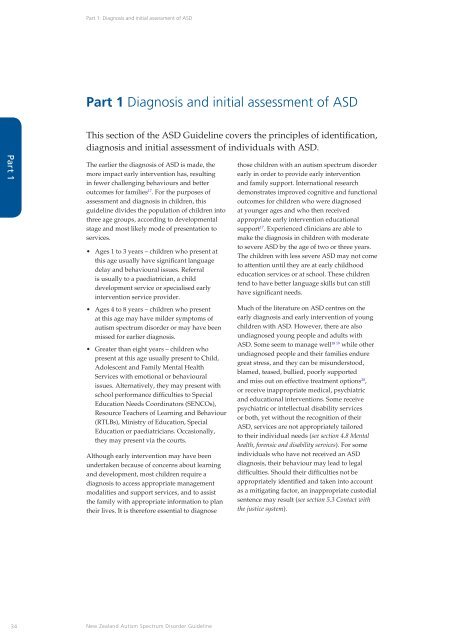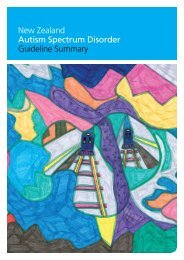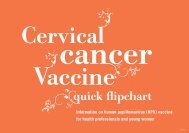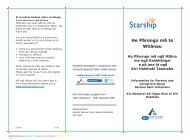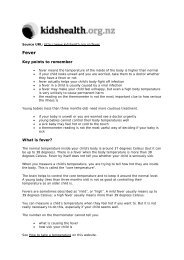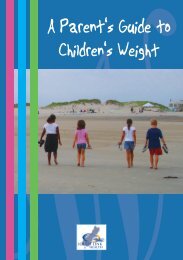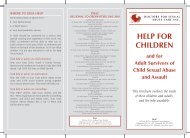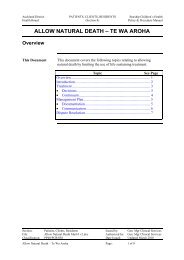New Zealand Autism Spectrum Disorder Guideline - Ministry of Health
New Zealand Autism Spectrum Disorder Guideline - Ministry of Health
New Zealand Autism Spectrum Disorder Guideline - Ministry of Health
Create successful ePaper yourself
Turn your PDF publications into a flip-book with our unique Google optimized e-Paper software.
Part 1: Diagnosis and initial assessment <strong>of</strong> ASD<br />
Part1 Diagnosis and initial assessment <strong>of</strong> ASD<br />
This section <strong>of</strong> the ASD <strong>Guideline</strong> covers the principles <strong>of</strong> identification,<br />
diagnosis and initial assessment <strong>of</strong> individuals with ASD.<br />
Part 1<br />
The earlier the diagnosis <strong>of</strong> ASD is made, the<br />
more impact early intervention has, resulting<br />
in fewer challenging behaviours and better<br />
outcomes for families 17 . For the purposes <strong>of</strong><br />
assessment and diagnosis in children, this<br />
guideline divides the population <strong>of</strong> children into<br />
three age groups, according to developmental<br />
stage and most likely mode <strong>of</strong> presentation to<br />
services.<br />
• Ages 1 to 3 years – children who present at<br />
this age usually have significant language<br />
delay and behavioural issues. Referral<br />
is usually to a paediatrician, a child<br />
development service or specialised early<br />
intervention service provider.<br />
• Ages 4 to 8 years – children who present<br />
at this age may have milder symptoms <strong>of</strong><br />
autism spectrum disorder or may have been<br />
missed for earlier diagnosis.<br />
• Greater than eight years – children who<br />
present at this age usually present to Child,<br />
Adolescent and Family Mental <strong>Health</strong><br />
Services with emotional or behavioural<br />
issues. Alternatively, they may present with<br />
school performance difficulties to Special<br />
Education Needs Coordinators (SENCOs),<br />
Resource Teachers <strong>of</strong> Learning and Behaviour<br />
(RTLBs), <strong>Ministry</strong> <strong>of</strong> Education, Special<br />
Education or paediatricians. Occasionally,<br />
they may present via the courts.<br />
Although early intervention may have been<br />
undertaken because <strong>of</strong> concerns about learning<br />
and development, most children require a<br />
diagnosis to access appropriate management<br />
modalities and support services, and to assist<br />
the family with appropriate information to plan<br />
their lives. It is therefore essential to diagnose<br />
those children with an autism spectrum disorder<br />
early in order to provide early intervention<br />
and family support. International research<br />
demonstrates improved cognitive and functional<br />
outcomes for children who were diagnosed<br />
at younger ages and who then received<br />
appropriate early intervention educational<br />
support 17 . Experienced clinicians are able to<br />
make the diagnosis in children with moderate<br />
to severe ASD by the age <strong>of</strong> two or three years.<br />
The children with less severe ASD may not come<br />
to attention until they are at early childhood<br />
education services or at school. These children<br />
tend to have better language skills but can still<br />
have significant needs.<br />
Much <strong>of</strong> the literature on ASD centres on the<br />
early diagnosis and early intervention <strong>of</strong> young<br />
children with ASD. However, there are also<br />
undiagnosed young people and adults with<br />
ASD. Some seem to manage well 18 19 while other<br />
undiagnosed people and their families endure<br />
great stress, and they can be misunderstood,<br />
blamed, teased, bullied, poorly supported<br />
and miss out on effective treatment options 20 ,<br />
or receive inappropriate medical, psychiatric<br />
and educational interventions. Some receive<br />
psychiatric or intellectual disability services<br />
or both, yet without the recognition <strong>of</strong> their<br />
ASD, services are not appropriately tailored<br />
to their individual needs (see section 4.8 Mental<br />
health, forensic and disability services). For some<br />
individuals who have not received an ASD<br />
diagnosis, their behaviour may lead to legal<br />
difficulties. Should their difficulties not be<br />
appropriately identified and taken into account<br />
as a mitigating factor, an inappropriate custodial<br />
sentence may result (see section 5.3 Contact with<br />
the justice system).<br />
34<br />
<strong>New</strong> <strong>Zealand</strong> <strong>Autism</strong> <strong>Spectrum</strong> <strong>Disorder</strong> <strong>Guideline</strong>


